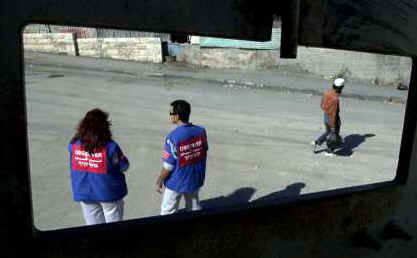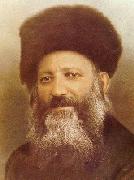 http://www.israelnationalnews.com/article.php3?id=6909By Rabbi Dawidh Hanokh Bar-Hayim
http://www.israelnationalnews.com/article.php3?id=6909By Rabbi Dawidh Hanokh Bar-HayimWhen, as a teenager, my father used to tell me that he did not like me wearing jeans, I usually asked: "Why not? After all," I would point out, "what difference does it make what material the pants are made of?"
My father's reply – referring to the hippie/rock and roll/anti-establishment subculture of the day - typically went something like this: "It is not the jeans, my son, it is what they represent."
Now let's switch frames, to the Torah commandment to wear tzitzith on a four-cornered garment: "Speak to the Children of Israel, and tell them to make for themselves, in all generations, fringes on the corners of their garments; and they shall attach to the fringe of each corner a thread of blue." (Numbers 15:38) The mitzvah (commandment) is comprised of two parts: to place white strings on the corners, and to tie an additional string of techeleth (a bluish dye) around the other strings. The first part is easy. The second is tricky. Or used to be.
A Look at the SourcesAccording to tradition, the blue in question must be of a specific type: it is a very beautiful and permanent dye produced from a particular mollusc found in the Mediterranean. In the wake of the Islamic conquest of the entire Mediterranean region (7th-8th centuries CE), the specialised knowledge required for this dyeing process was lost. Thus, we find Maimonides (12th century) stating that the techeleth element of the mitzvah is "not possible today, and we therefore do the white only." (Mishnah commentary, Menahoth 4:1)
And so things remained, until less than 20 years ago. The facts are fascinating, but suffice it to say that due to the efforts of one rabbi, the source of the dye and the chemical process involved in actually dyeing wool techeleth are well known today. To have a packet of tzitzith with techeleth sent to your home, all you need to do is pick up the phone or go online.
Great news, right? Apparently not; the overwhelming majority of Orthodox Jews do not wear it. The question is why not, particularly since "the main part of the mitzvah is the techeleth, for which reason the entire tzitzith is referred to as techeleth." (Rabbi Asher, "Laws of Tzitzith," no. 17)
The Blue PerilSome Halachic authorities have claimed - historical, archaeological and Talmudic evidence notwithstanding - that the identification of the mollusc is not certain. Others, in a last-ditch effort to stave off the blue peril, have suggested that using a bluish string that is not in fact techeleth might render the entire tzitzith unacceptable. No convincing proof has been adduced for this unlikely supposition.
Remember: we are speaking of great rabbis, masters of Halacha, who will normally go much farther than the proverbial extra mile in order to fulfil a mitzvah. Regarding this commandment, however, the usual zeal seems entirely absent.
The issue, in my humble opinion, is not one of identification. Nor are Halachic concerns the name of the game. The problem is not the techeleth, but rather what it represents. And that can be summed up in one word: change.
The Status Quo as a MitzvahOne of our greatest strengths as a people has been our adherence to tradition. Throughout the Galuth (Exile), our forefathers gave their all to ensure that we, their descendants, would continue to live in accordance with the Torah. To this end, a strategy was developed, a central feature of which was an extremely rigid conformance to minhag (customary practice) and a sanctification of the present state of Jewish affairs. It is fair to say that in the fullness of time, this came to be the essential yardstick and paramount concern of Judaism; the status quo became a mitzvah.
As with everything else, however, one can have too much of a good thing: when this ingrained arch-conservatism serves to endorse a philosophy that places minhag above explicit Torah precepts - a classic case of the means overtaking the end - one cannot avoid the conclusion that the system has broken down.
To better understand the nature of the difficulty, imagine a number of bricks - let's say, ten - laid out in a tight circle, resembling a clock-face. If you were handed an eleventh brick and asked to incorporate it into the circle, you would have two options: remove one of the existing bricks and replace it with the new one, or break up the circle and create a new and wider circle, which could accommodate the eleventh brick.
Now imagine the Torah and the mitzvoth. These, too, are such a system, forming an immense and perfect circle. But here's the catch: the Galuth-version of the Torah is not the real McCoy; it is a scaled-down model, a product of the cataclysm of the Hurban (the destruction of the Temple) and the collapse of the Second Jewish Commonwealth. Over time, we have come to view it as the genuine article, with the result that our undersized circle is regarded as sacrosanct. Removing a brick or expanding the circle - even if only to reconstitute it as the Torah demands - is considered beyond the pale. The abnormal has thus become the norm.
Torah: Reality or Folklore?It is not only techeleth that has proved altogether too much for the existing Halachic paradigm; it is reality itself. A rabbi who does not know what to do when presented with an innocuous thread of blue is unlikely to have the answers regarding more weighty matters such as rebuilding the Temple or re-establishing the Sanhedrin. Nor is he likely to have given much thought to how a modern Jewish state is to be governed: does the Halachic framework for this exist? If not, who is going to formulate it?
And what of socio-economic questions? The Torah and the Prophets speak of these matters at length, educating, instructing and commanding us to be more caring, less selfish, to establish a model society. Is the voice of Torah heard on these issues today? Who will do this if not rabbis who possess an acute and insightful understanding of the Oral Tradition?
Present-day Orthodoxy, born in the crucible of Galuth, has no room for 'new' mitzvoth - even if they are very old. The essential article of faith of the frum world - "that which is new is forbidden" (first introduced 200 years ago as Orthodoxy's battle cry in its war with the German Reform movement) - does not allow for innovation and originality, even when the Torah demands it.
When faced with the task of implementing the Torah, in all its aspects and manifestations - from techeleth to trade and industry - the rabbinical establishment is, sadly, completely out of its depth. And when rabbis are unable to deal with Torah and make it work in the real world, we, the Jewish people, are in a state of profound crisis.
It's enough to make you blue.









